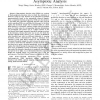Free Online Productivity Tools
i2Speak
i2Symbol
i2OCR
iTex2Img
iWeb2Print
iWeb2Shot
i2Type
iPdf2Split
iPdf2Merge
i2Bopomofo
i2Arabic
i2Style
i2Image
i2PDF
iLatex2Rtf
Sci2ools
TIT
2016
2016
Opportunistic Detection Rules: Finite and Asymptotic Analysis
—Opportunistic detection rules (ODRs) are variants of fixed-sample-size detection rules in which the statistician is allowed to make an early decision on the alternative hypothesis opportunistically based on the sequentially observed samples. From a sequential decision perspective, ODRs are also mixtures of one-sided and truncated sequential detection rules. Several results regarding ODRs are established in this paper. In the finite regime, the maximum sample size is modeled either as a fixed finite number, or a geometric random variable with a fixed finite mean. For both cases, the corresponding Bayesian formulations are investigated. The former case is a slight variation of the well-known finite-length sequential hypothesis testing procedure in the literature, whereas the latter case is new, for which the Bayesian optimal ODR is shown to be a sequence of likelihood ratio threshold tests with two different thresholds. A running threshold, which is determined by solving a stat...
| Added | 11 Apr 2016 |
| Updated | 11 Apr 2016 |
| Type | Journal |
| Year | 2016 |
| Where | TIT |
| Authors | Wenyi Zhang, George V. Moustakides, H. Vincent Poor |
Comments (0)

